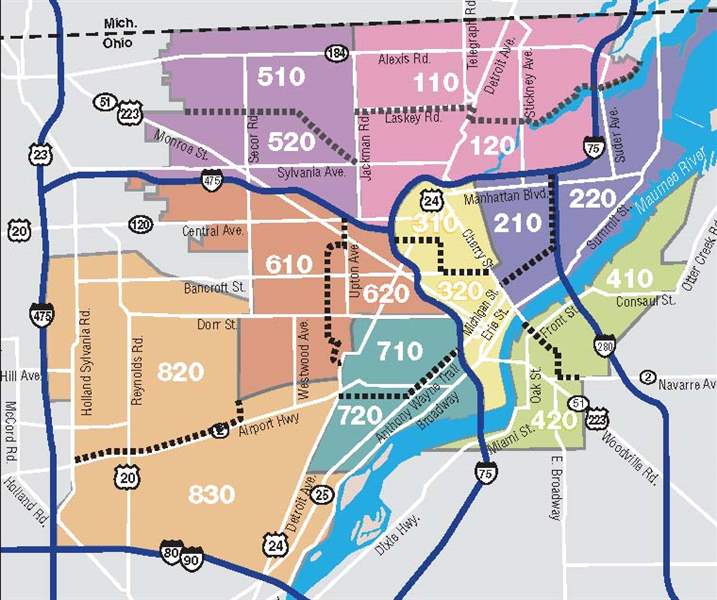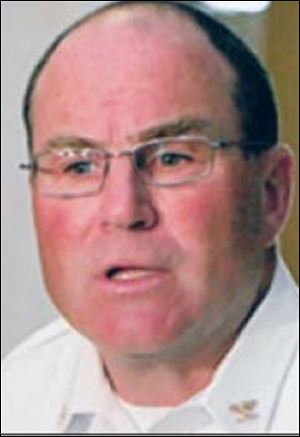
Toledo police beats adjusted to balance force's size
9/14/2009
As of Sept. 1, the Toledo Police Department changed assignments for its patrol officers. It carved the city up into eight sectors instead of seven, while reducing the number of street beats from 51 to 16. The change has resulted in two beats per sector. The call numbers for each beat are shown within each of the eight sectors. Police Chief Mike Navarre said the eight-sector plan does not restrict movement of officers to any one part of the city or prohibit them from making arrests outside of their assigned areas.

Navarre
Make do with less.
It's been a common refrain - almost a battle cry - for people in these tough economic times.
But when it comes to public safety, there's not much wiggle room for law enforcement.
Few agencies have learned that lesson more than the Toledo Police Department this year.
First, there was the layoff of 75 police officers in the spring. That prompted police Chief Mike Navarre to beef up street patrols with field detectives and officers who had been in other specialized positions, such as community service programs, crime analysis, recruit training, and vice/narcotics.
Although 60 of those jobs have been restored, the department still would fall short of being ideally staffed even if the remaining 15 officers are recalled, Chief Navarre said.
The police department's work force of 592 sworn officers is down 42 from the 634 officers it had seven months ago because of jobs left vacant after retirements. The work force also is 148 fewer officers than the peak level of 740 in the mid-1990s, Mr. Navarre said.

As of Sept. 1, the Toledo Police Department changed assignments for its patrol officers. It carved the city up into eight sectors instead of seven, while reducing the number of street beats from 51 to 16. The change has resulted in two beats per sector. The call numbers for each beat are shown within each of the eight sectors. Police Chief Mike Navarre said the eight-sector plan does not restrict movement of officers to any one part of the city or prohibit them from making arrests outside of their assigned areas.
On Sept. 1, the department activated a plan for assigning officers on street beats.
Based on how the city's crime rate has evolved, it is the first major overhaul of assignments since 1995 and only the third reorganization in Chief Navarre's 32 years
on the force.
The first was in the mid 1980s.
Instead of 51 street beats, there are 16.
The department has divided the city into eight sectors.
Officers patrol two street beats in each sector.
Although the plan that went into effect in 1995 had 51 beats, there were only seven sectors. And rarely were there enough officers to staff all 51 beats.
The size of each new sector was determined with historic crime rates in mind, Chief Navarre said.
The chief also said he is encouraging officers to assist in other sectors more often.
He said he wants a minimum of 31 officers on the street and will continue to augment those numbers between 8 p.m. and 4 a.m. There are 41 officers on that shift, 20 downtown and 21 operating out of the Scott Park district station.
Each sector has at least two units, with one or two officers per vehicle. Sectors 1, 2, and 5 have been assigned three units. Sector 8 is the only one to get four.
As part of the recent contract negotiations, the administration has agreed to reinstate a noon-to-8 p.m. shift eliminated two years ago. It also has agreed to begin four, 10-hour shifts on a trial basis. Both begin Jan. 1, Chief Navarre said.
The new plan for manning the streets occurred after a five-month redistricting study conducted by Toledo police Lt. Mike Troendle in which he reviewed calls for service and self-initiated police activity between January, 2007, and June, 2008.
It emerged as the favorite of four options that Lieutenant Troendle presented to the administration.
Chief Navarre said an updated management plan probably would have been necessary even if the cutbacks hadn't occurred because "the demographics are always changing."
In short, the department is trying to outfox criminals by putting its officers in the most strategic locations.
With fewer officers available, such decisions are all the more important.
Chief Navarre had a three-word response when asked how the new plan is working.
"Perfect," he said. "No problems."
He hardly got agreement from Dan Wagner, president of the Toledo Police Patrolman's Association.
Mr. Wagner said he has heard numerous gripes from officers on the street since the plan went into effect on Sept. 1. The union president said he hopes the administration ultimately realizes it is an "unworkable" plan and reverts to something similar - though not necessarily identical - to what went into effect in 1995.
"There's already been some negative feedback on it," Mr. Wagner said. "We're at such rock-bottom numbers that some areas are going unfilled and officers are scrambling to cover them."
Of particular concern is the city's southwest quadrant, where units 820 and 830 work. That's the most diffuse coverage area in the city, which Mr. Wagner said could result in longer response times there.
When street beats were last reorganized in 1995, the department was on a hiring upswing. Coverage was done with the belief that recruits would be hired faster than veterans retired, allowing the department to keep expanding.
"It was constructed to accommodate a growing police department," Mr. Navarre said of the 1995 plan.
He said it became largely obsolete as officer numbers dropped.
"The plan we had really wasn't accommodating current manpower levels," he said. "It was time to do it again."
Now the objective is covering as much territory with as few officers as possible.
Although many of the changes will go unnoticed by the general public, residents who listen to police traffic on scanners might want to take note of some new call numbers.
Detectives, for example, have call numbers between 1,000 and 1,199. They had been in the 800s.
Those numbers are now reserved for patrol officers, with the exception of call number 810. That belonged to Keith Dressel, the detective in the vice/narcotics unit who was slain on duty in 2007. His 810 call number and his No. 679 badge have been retired, Chief Navarre said.
Realigning the street beats could change the way residents get on the Toledo Neighborhood Block Watch Program's board of directors.
Michael Dearth, the program's chairman, said he would prefer to keep the board at 13 members to help avoid tie votes. The board has a member elected by the leadership of each sector, plus one member appointed by the police chief, two by City Council, and three by the mayor.
With eight sectors, there likely would be one fewer appointed position, Mr. Dearth said.
Talks to make a change have just begun, he said.
Contact Tom Henry at:
thenry@theblade.com
or 419-724-6079.